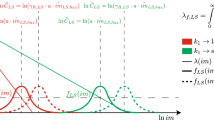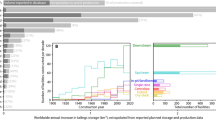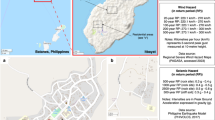Abstract
Earthquakes can occur in most regions of the United States, so it might be necessary to reinforce vulnerable animal facilities to better protect research animals during these unpredictable events. A risk analysis should include an evaluation of the seismic hazard risk at the proposed building site balanced against the estimated consequences of losses. Risk analysis can help in better justifying and recommending to building owners the costs of incorporating additional seismic reinforcements. The planning team needs to specify the level of post-earthquake building function that is desired in the facility, and then design the facility to it.
This is a preview of subscription content, access via your institution
Access options
Subscribe to this journal
We are sorry, but there is no personal subscription option available for your country.
Buy this article
- Purchase on Springer Link
- Instant access to full article PDF
Prices may be subject to local taxes which are calculated during checkout

Similar content being viewed by others
References
Building Seismic Safety Council. Seismic Considerations—Health Care Facilities (FEMA 150) 7–15 (FEMA, Washington, DC, 1990).
Witt, J.L. in Building a Disaster-Resistant University (FEMA 443) v–vii (FEMA, Washington, DC, 2004).
Normile, D. Kobe earthquake. Faculty pick up the pieces of shattered research projects. Science 268(5216), 1429–1431 (1995).
FEMA. Communicating with Owners and Managers of New Buildings on Earthquake Risk: A Primer for Design Professionals (FEMA 389) (FEMA, Washington, DC, 2004).
Building Seismic Safety Council. National Earthquake Hazards Reduction Program Recommended Provisions for Seismic Regulations for New Buildings and Other Structures 2000 Edn. (FEMA 369) (FEMA, Washington, DC, 2001).
Bertero, V.V. Proper selections for the superstructure. Selection of the proper system and configuration for the superstructure. Earthquake engineering set J (ed. Godden, W.G.) (Structural Engineering Slide Library, University of California, Berkeley, 1997). http://nisee.berkeley.edu/bertero/html/earthquake-resistant_construction.html.
Building Seismic Safety Council. Seismic Considerations—Health Care Facilities (FEMA 150) 23–42 (FEMA, Washington, DC, 1990).
Hessler, J.R. & Leary, S.L. in Laboratory Animal Medicine, 2nd Edn. (eds. Fox, J.G., Anderson, L.C., Loew, F.M. & Quimby, F.W.) 909–954 (Elsevier Science USA, New York, 2002).
Building Seismic Safety Council. Seismic Considerations—Health Care Facilities (FEMA 150) 43–58 (FEMA, Washington, DC, 1990).
FEMA. An Action Plan for Reducing Earthquake Hazards of Existing Buildings, Introduction (FEMA 90) 7–18 (FEMA, Washington, DC, 1985).
ATC/SEAOC Joint Venture Training Curriculum. Built to resist earthquakes: the path to quality seismic design and construction, Briefing Paper 3: Seismic response of wood-frame construction, Part C: The role of wood-framed shear walls. http://www.atcouncil.org/pdfs/bp3c.pdf.
ATC/SEAOC Joint Venture Training Curriculum. Built to resist earthquakes: the path to quality seismic design and construction, Briefing Paper 3: Seismic response of wood-frame construction, Part A: How Earthquakes Affect Wood Buildings. http://www.atcouncil.org/pdfs/bp3a.pdf.
ATC/SEAOC Joint Venture Training Curriculum. Built to resist earthquakes: the path to quality seismic design and construction, Briefing Paper 4: Seismic response of concrete and masonry buildings, Part D: The importance of ductility. http://www.atcouncil.org/pdfs/bp4d.pdf.
ATC/SEAOC Joint Venture Training Curriculum. Built to resist earthquakes: the path to quality seismic design and construction, Briefing Paper 3: Seismic response of wood-frame construction, Part B: The role of wood-framed diaphragms. http://www.atcouncil.org/pdfs/bp3b.pdf.
ATC/SEAOC Joint Venture Training Curriculum. Built to resist earthquakes: the path to quality seismic design and construction, Briefing Paper 5: Seismic response of nonstructural components, Part A: Overview of component types and behavior. http://www.atcouncil.org/pdfs/bp5a.pdf.
ATC/SEAOC Joint Venture Training Curriculum. Built to resist earthquakes: the path to quality seismic design and construction, Briefing Paper 5: Seismic response of nonstructural components, Part C: Proper anchorage of cladding and equipment. http://www.atcouncil.org/pdfs/bp5c.pdf.
ATC/SEAOC Joint Venture Training Curriculum. Built to resist earthquakes: the path to quality seismic design and construction, Briefing Paper 5: Seismic response of nonstructural components, Part B: Proper anchorage of ceilings, interior walls, glazing and parapets. http://www.atcouncil.org/pdfs/bp5b.pdf.
ATC/SEAOC Joint Venture Training Curriculum. Built to resist earthquakes: the path to quality seismic design and construction, Briefing Paper 5, Seismic response of nonstructural components, Part A: Overview of component types and behavior. http://www.atcouncil.org/pdfs/bp5a.pdf.
ATC/SEAOC Joint Venture Training Curriculum. Built to resist earthquakes: the path to quality seismic design and construction, Briefing Paper 2: Roles and responsibilities of engineers, architects and code enforcement officials, Part B: Identification and resolution of major issues. http://www.atcouncil.org/pdfs/bp2b.pdf.
Building Seismic Safety Council. Seismic Considerations—Health Care Facilities (FEMA 150) 15–19 (FEMA, Washington, DC, 1990).
Author information
Authors and Affiliations
Corresponding author
Ethics declarations
Competing interests
The authors declare no competing financial interests.
Rights and permissions
About this article
Cite this article
Vogelweid, C., Hill, J., Shea, R. et al. Earthquakes and building design: a primer for the laboratory animal professional. Lab Anim 34, 35–42 (2005). https://doi.org/10.1038/laban0705-35
Received:
Accepted:
Issue Date:
DOI: https://doi.org/10.1038/laban0705-35



